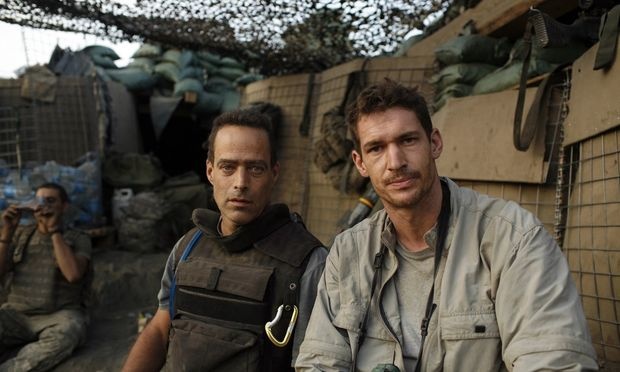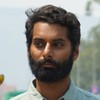
Sebastian Junger: That was something he said many times in conversation with me and in interviews. You know I think someone of his creative talent and genius easily feels limited by things. And I think he saw the possibilities of photography, but was also very aware of its limitations. I think what he really wanted was to experience the world and understand the human struggle. That's really what he wanted. Photography was kind of his excuse to do that. He just also was extremely talented and so became extremely good photographer, but it just wasn't the central narrative in his head of what he was trying to get out of the world—it was a means to an end.
Top: Cunningham, Korengal Valley, Kunar Province, Afghanistan, 2008. Bottom: Specialist Tad Donoho, Korengal Valley, Kunar Province, Afghanistan, 2008. Courtesy Yossi Milo Gallery In making the film, did you learn something about him that you didn't know before? I wasn't quite so aware of the gentler side of him. I didn't realize that until I saw the footage he shot from Sri Lanka. I'd known him in the context of war and that requires a certain set of characteristics and behaviors, and the way he was with children he photographed was so sweet and I just didn't quite ever see that, certainly not at work. And that was a really nice discovery and I kind of got to know him a little bit better in doing the film because I saw him in all these unguarded moments and, yeah that was really nice.
That was sort of classic Tim. He over thought everything and made his life a lot harder because of that. But he also understood the media and he understood what the media wants, what the media is satisfied with is a very low level of understanding. So you can sort of put out a boilerplate, humanistic sensitivity about the human struggle and no one's going to bat an eye—that's what they expect, it doesn't mean much, but it works fine. And Tim was smart enough to realize that that's really bullshit, and that anyone can pay lip service to that stuff and it doesn't mean anything and so he was self correcting because the media can't be bothered to correct in that situation, you know they're fine with the first thing he said, but Tim wasn't fine with it and he realized he was not being honest and was not saying something of real meaning and so he kept correcting himself, that was classic Tim.What did you learn from Tim?
I learned how to not focus on the obvious aspects of a story, and most dramatic aspects of a story, particularly combat.I learned to sort of look at what was happening one or two layers beneath in the sort of emotional realm. I learned to do that.
It affected the traits of his that I focused on. This is sort of circular, but it got me to focus on that part of him that I had learned from."Diary," by Tim Hetherington, 2010Do you remember the first Time you met Tim?
Yeah it was at the departure gate a Heathrow airport on our way into Afghanistan on assignment for Vanity Fair.You knew of him before?
Kind of, I mean I knew that this extraordinary film had been shot in Liberia and one of the reasons I chose Tim to work with. One of the reasons I wanted to work with Tim was because he was an excellent photographer so Vanity Fair wanted to hire him but also I knew that he could shoot video so I said 'look, I have this movie project, Vanity Fair has nothing to do with it, but you might be interested,' and he was.What'd you guys talk about on the plane?
Girls probably, I don't remember. I probably told him a lot about what it was like over there. He really liked to laugh, big laugh. He was pretty close to perfect to people who encountered him. He was, psychologically, very complicated and had some real veins of deep unhappiness running through him, real torment. And eventually that came out in his relationships with other people who were close enough to him. I don't mean just romantic relationships, those too, but even in our friendship. He was complicated. But he was a really, deeply good person.This post originally appeared at VICE.More from Tim:The Doodles of War: Child Soldiers Tag Liberia
